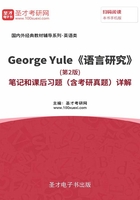
第1章 语言的起源
1.1 复习笔记
本章重点介绍语言的起源,并从不同的角度探索语言的起源。语言的起源是语言学的基本理论问题之一,语言在生命的开庭之日就已经诞生,语言不是枯燥无味的反而充满了趣味。
人类何时萌发对语言的兴趣已无法确切考证。人类经历了几千年的文明演变,知识一直在积累,语言一直在变化,一切都变得面目全非。由于考证资料有限,直接证据匮乏,人类语言起源问题难下定论。
本章要点:
1.The divine source 神授说
2.The natural-sound source 自然声音模仿说
3.The oral-gesture source 口语—手势相关说
4.Glossogenetics 言语遗传学
本章考点:
语言的起源(神授说,人造说自然声音模仿说,口语-手势相关说,言语遗传学等)。
本章内容索引:
I. The divine source
II. The natural-sound source
1.The bow-wow theory
2.The yo-he-ho theory
III. The oral-gesture source
1.Theory
2.Problem
IV. Glossogenetics
1.Definition
2.Physiological adaptation
V. Interactions and transactions
1.Interactional function
2.Transactional function
I. The divine source(神授说)
【考点】神授说的定义
God created and Adam and “whatsoever Adam called every living creature, that was the name thereof” (Genesis 2:19).
In most religions, there appears to be a divine source who provides humans with language. In an attempt to rediscover this original, divine language, a few experiments have been carried out, with rather conflicting results.
据《圣经》中“创世纪”记载,亚当给万物命名,万物因此得名。
大多数宗教将语言的起源归功于神,有的甚至试图用实验来证明人类的初始语言,但结果是互相矛盾的。
II. The natural-sound source(自然声音模仿说)
【考点】自然声音模仿说的两种相关理论
Primitive words could have been the imitations of the natural sounds.
人类先民闻自然界的声音而模仿之,造出了最原始的词语。
1.The bow-wow theory(摹声说)
①Primitive words could have been imitations of the natural sounds that early humans heard around them.
②Problem: most of the soundless, abstract entities can’t be referred to in this theory.
①最原始的词语是模仿身边自然界的声音而形成的。
②问题:该理论无法涉及大部分没有声音的或者抽象的实体。
2.The yo-he-ho theory(劳动号子说(“哟—嘿—吼”理论))
①The sounds of a person involved in physical effort could be the source of our language, especially when that physical effort involved several people and had to be coordinated.
②Problem: It doesn’t answer the questions regarding the origins of the sounds produced.
①人们从事体力劳动发出的声音可能是语言的起源,尤其当该劳动需要多人共同协作完成时。
②问题:该理论并没有回答这些发出的声音的起源。
III. The oral-gesture source(口语—手势相关说)
1.Theory(理论观点)
The origins of the sounds of language involve a link between physical gesture and orally produced sound.
语言的发音起源与手势和口头发音之间的联系有关。
2.Problem(问题)
It is hard to visualize the actual “oral” aspect which would mirror such gestures.
很多描述一些动作的口头发音是很难看出来的。
IV. Glossogenetics(言语遗传学说)
【考点】言语遗传学说的定义及相关发音部位
1.Definition(定义)
Glossogenetics focuses on the biological basis of the formations and development of human language.
In the evolutionary development, there are certain features, best thought of as partial adaptations that appear to be relevant for speech.
该学说认为,人类语言的形成与发展具有生物基础。
在发展进化过程中,人类为适应环境而发生的部分变化似乎与语言功能相关。
2.Physiological adaptation(生理适应)
Teeth: upright and roughly even in height.
Lips: have much more intricate muscle interlacing and the resulting flexibility.
Mouth: relatively small, can be opened and closed quickly.
Larynx: lowered, creating a longer cavity called the pharynx, and making the sound speech possible.
Human brain: has the feature of lateralization; divided into a left side and a right side, with control of functions on one side or the other.
牙齿:直立、有一定的高度。
嘴唇:肌肉复杂,更具灵活性。
嘴:相对较小,能迅速张开、闭合。
喉:位置下降,并形成了一个长的腔道叫做咽,使人能够发出声音。
人脑:具有偏侧优势特征;大脑分为左右两侧,两侧有各自的分工。
V. Interactions and transactions(交互功能与传递功能)
1.Interactional function(交互功能)
It has to do with how humans use language to interact with each other, socially or emotionally; how they indicate friendliness, co-operation or hostility, or annoyance, pain, or pleasure.
交互功能是关于人类如何利用语言来彼此进行社交或情感交流,表达友好、合作、敌意、烦恼、痛苦、愉悦等情感信息。
2.Transactional function(传递功能)
Humans use their linguistic abilities to communicate knowledge, skills and information.
传递功能指的是人类使用语言能力传播知识、技能和信息。